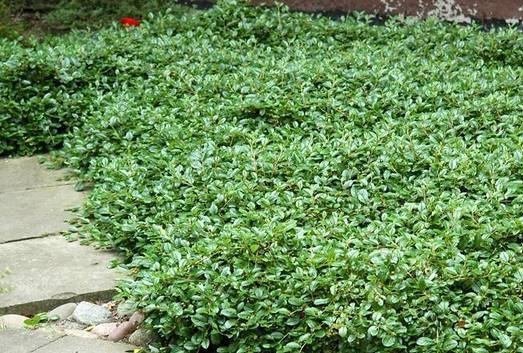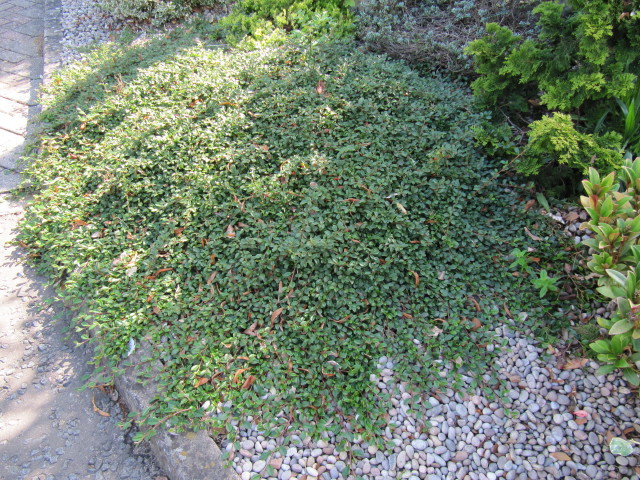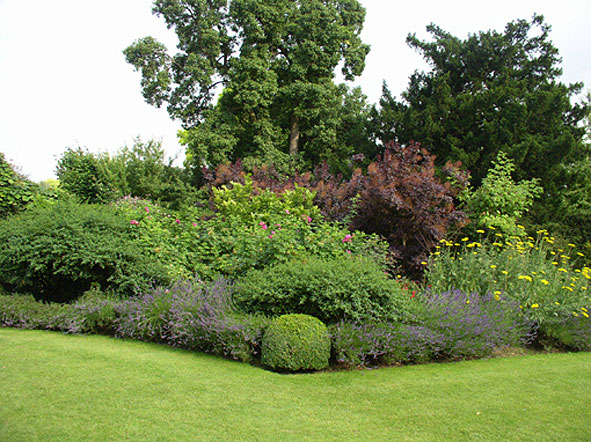Content
A horizontal cotoneaster is one of the most common varieties of a cotoneaster, which is used to decorate summer cottages, as well as to beautify adjoining territories. Often this plant is used not only for ground cover, but also in rock gardens, as well as for creating a hedge.
Description of the horizontal cotoneaster
The horizontal cotoneaster is a lush shrub from the Pink family. Wild specimens of this plant are found in China. It's evergreen perennial shrubwho does not lose his "clothes" for the winter.
Shoots, as the name implies, grow horizontally and spread along the ground. The plant does not grow above 1 meter in height. At the same time, it grows in width up to 2 meters. Such shoots perfectly mask unsightly and stony areas of the earth.
The shoots of the horizontal cotoneaster are most often located in the same plane and have the shape of a fish ridge with one large branch and symmetrically located processes.
The shrub leaves are small - up to 1.5 cm in diameter. The surface is smooth and shiny. In autumn, the foliage on the shrub changes its color to red or crimson.
The cotoneaster blooms in early May, and the flowering process lasts 3 weeks. The flowers do not have a bright attractive color and are usually tinged with a light pink hue.
Fruits from an ornamental shrub are inedible, because they do not have a pronounced taste. But at the same time, they are not poisonous, therefore, if the family has children, decorating the site with a cotoneaster is a safe option.
The shrub does not need to be covered, as it tolerates frost calmly. This is an excellent decorating solution for the northern regions of the country.
As for diseases and pests, the cotoneaster most often suffers from fusarium. This is due to the fact that the plant does not tolerate high humidity, and the fungus starts up quickly. Affected shoots must be cut off and destroyed. The most common pests that are dangerous to shrubs are aphids and spider mites. In this case, it is enough to treat the shrub with a good insecticide.
Horizontal cotoneaster varieties
Before planting a horizontal cotoneaster, you need to select a variety. Popular varieties of cotoneaster, which are most often used for planting for decorative purposes:
- VariegatusIs a creeping plant, reaching a height of up to 30 cm. The main feature is an evergreen shrub only in warm and temperate latitudes, and in cold climates it turns into a deciduous plant.
- Perpusillis - a variety that is characterized by slow growth of shoots. The plant grows up to 50 cm in height. The leaves are dense and fleshy. Fruiting in late August, blooming in late May. The shrub is distinguished by its elegance and will decorate any site, especially in autumn, when it will stand out with a crimson spot against the background of conifers and evergreens.
These are the most popular varieties, which are often found in decorative areas and decorate territories, create hedges, as well as evergreen sculptures. The horizontal cotoneaster in the photo looks just as impressive as on the site itself.
Planting a horizontal cotoneaster
With proper planting and high-quality care, the plant will decorate the site for a long time and delight the owner with its smooth leaves. It is important to choose the right soil and place for planting, and then carry out simple maintenance.
Site selection and soil preparation
The horizontal cotoneaster differs from its related varieties in that it is picky about the soil on which it grows. He needs to have a fertile and nourishing environment for normal development. The soil must necessarily contain sand, peat and earth. The site must be dug up and leveled before planting.
It is desirable that the groundwater is deep, and ideally, the shrub itself is located on a small hill. And also the cotoneaster feels great on the slopes.
Landing rules
The cotoneaster planting algorithm is not complicated. First you need to prepare a pit with a drainage system. The thickness of the drainage layer of broken bricks is 20 cm. In addition to broken bricks, pebbles are excellent for drainage. The depth of the pit is 70 cm, and the width is up to 50 cm. More accurate parameters of the pit depend on the size of the root system. Seedlings with a closed root system should not be freed from the ground. Shaking off the clods can cause damage. This way it will be easier to dig in. In this case, the root collar should be flush with the ground. After planting, the seedling should be watered abundantly.
Follow-up care of the horizontal cotoneaster
Shrub care is also easy. First of all, it should be remembered that the horizontal cotoneaster does not tolerate excess water, but prefers drought. Therefore, even if the summer turned out to be without rain, watering the bush is enough once a week or two. In the presence of rain, the amount of watering is reduced. When watering under one bush, you cannot pour more than 5 buckets of water. If the soil is wet, then this indicator should also be reduced.
After watering, be sure to loosen the soil and weed, removing all weeds... As a spring fertilizer, a urea solution is applied under the bush. Before flowering, superphosphate or potash fertilizers must be added under the bush.
In addition, pruning is always present in the care. This helps to form a hedge or to shape the shrub into the desired shape.
Reproduction of a horizontal cotoneaster
The horizontal cotoneaster reproduces in several ways. The shrub can be propagated by growing seeds, as well as cuttings and layering. When propagating by seeds, a shrub will have to be grafted, most often a cotoneaster is grafted onto a hawthorn or mountain ash.
Cuttings
For propagation, you need cuttings. Healthy shoots that remain after pruning can be used as cuttings. Shoots should be prepared by cutting at an angle, and then put in a growth stimulator for a day. The stalk should have several buds and not show signs of damage from various diseases.
When the day has passed, the cuttings can be planted on the site in loosened and fertilized soil, which was specially prepared for them. After planting, all cuttings are covered with a plastic jar or bottle. The optimal time for planting and rooting cuttings is June. In this case, cuttings will become full-fledged plants already next spring. Cotoneaster horizontal propagates by cuttings quite well, this is the most common method of propagation.
Growing from seeds
Growing a full-fledged cotoneaster bush from seeds is quite troublesome, but the owner will be pleased with the results. The algorithm is simple:
- Harvest fruits in October and November.
- Remove the pulp from the seeds, rinse and dry.
- Soak in water, while all floating seeds are removed as defective.
- Mix seeds with peat and sand.
- Moisten the mixture.
- Put in boxes in a layer of 30-40 cm.
- The seeds should be 0.7 cm deep.
- Keep the box until spring at temperatures close to zero degrees.
- Cotoneaster germination - from 5 to 20%.
- During the germination period, the seeds should be watered, while making sure that the seeds are not exposed. If the seeds appear on the surface, deepen again to the required depth.
Seeds can be planted in the spring. In open ground, seedlings can be determined after the first 2 leaves have appeared on them.
Layers
The location of the horizontal cotoneaster provides for easy reproduction by layering. To do this, it is enough to press the shoots to the ground and pin them with staples. The place where the shoot is pressed should be covered with humus and peat. In the spring, you should cut off the main bush from the pinned layer and transplant the seedling to a permanent place.
Horizontal cotoneaster in landscape design
In gardening, it is the horizontal cotoneaster that is very much appreciated as an ornamental plant. The horizontal cotoneaster in landscape design can be seen in various photos. These are most often hedges and various structures. And you can also often use small varieties in the form of curb structures that adorn garden paths.
In group plantings, the dogwood shrub goes well with various conifers.
Used in landscaping parks, as well as sidewalks and recreation areas around the world. If you use a cotoneaster in rock gardens, then the middle tier is chosen for it.
It also looks great against the background of stones and rocky hills, and therefore is used in various combinations.
Conclusion
The decoration of a suburban area or park area will look completely different if, in combination with other plants, a horizontal cotoneaster bush is planted. This shrub is able to withstand frost and does not need constant watering at all. Unpretentious in the choice of soil, and propagates by cuttings and even seeds. As a result, the owner can quickly get a beautiful hedge with a fast-growing plant, which is also a long-liver. With proper care, the cotoneaster can live on the site for up to 50 years or more. The main thing is not to abuse watering when leaving, so that a fungus does not form.













